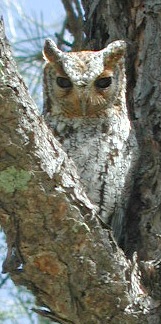 Northern Arizona Owls - May 25, 2016 Jeff Schalau, Agent, Agriculture & Natural Resources University of Arizona Cooperative Extension, Yavapai County Owls are elusive birds and are the subject of myth and legends worldwide. In most cases, these myths portray owls as evil or ominous. More recently, farmers and natural resource managers have embraced owls as key management species. Owls are found on every continent except Antarctica and in various habitats including forests, woodlands, prairies, and deserts. Owls feed on a range of mammals, birds, reptiles, fish, insects, snails, earthworms, spiders, and crustaceans depending on the owl species and habitat it occupies. According to the Sibley Field Guide to Birds of Western North America, we have several species of owls in northern Arizona. Year-round we have the barn owl, western screech owl, great horned owl, Mexican spotted owl, northern pygmy owl, and northern saw-whet owl. Summer can bring us the flammulated owl and burrowing owl. On rare occasions, we may also encounter the long-eared owl. Owls are recognizable by their: large, round head; large, forward-facing eyes; sharp, downward-facing beak; and large talons. They have exceptional vision, acute hearing, and have the ability to fly silently. This unique combination of features set them apart from any other creature and gives them extraordinary hunting abilities. After eating, owls regurgitate pellets, which contain the indigestible bones, fur and feathers of their prey. These pellets can be collected to study owls' eating habits and are often used to teach children about predator/prey relationships. Owls often breed in the spring and are usually monogamous for the breeding season. The male attracts a female to a suitable nest site and may use special courtship flights, calls, and offerings of food. Mating often follows the acceptance of food by the female. Owls do not construct nests. Instead, they use ready-made sites or take over the abandoned nests of other birds. Owls are known to protect their nest sites and can be vicious if the intruder persists. Most owls are active at dusk and dawn, spending the daytime at a quiet, inconspicuous roost outside of the breeding season. They generally roost singly or in pairs, but may form flocks (a flock of owls is called a “parliament”). Owls have a very wide range of vocalizations, ranging from hoots, to whistles, screeches, screams, purrs, snorts, chitters, and hisses. Hooting can be either territorial or associated with courting, the male usually having the lower pitched hoot. Not all owl species hoot. Owl species can also be identified by their vocalizations. Last summer, I heard what I thought was a pair of western screech owls outside my home. To confirm the species, I visited a web site that has several recordings of owl vocalizations and found a match (see online edition – use URL below). The site contains lots of other information about owls. Some of the calls on the site were recorded by Clarkdale, AZ Mayor, Doug Von Gausig. Because owls are predators, they are feared by many birds. For this reason, they are often attacked or harassed by groups of smaller birds. This is not limited to one species, as once the attack begins, many different bird species may join in. The mobbing may succeed in forcing the owl to move on to a different area. The retreating owl is often pursued by the mob. This is how I found a flammulated owl in my yard a couple of years ago. A flock of blue jays chased it into a ponderosa pine tree and I was able to photograph it (see photo at the on-line version of this column). In California, many growers have placed barn owl nest boxes in their orchards and vineyards to control pocket gophers, wood rats, voles (meadow mice), deer mice, and house mice. Barn owl predation of small rodents is an example of biological pest management. I have included a link to plans for building, siting, and mounting barn owl nest boxes with the online edition. I am not aware of any barn owl nest boxes in the Verde Valley, but if any readers are aware of any, please let me know. Follow the Backyard Gardener on Twitter – use the link on the BYG website. If you have other gardening questions, call the Master Gardener help line in the Camp Verde office at 928-554-8992 or e-mail us at verdevalleymg@gmail.com and be sure to include your name, address and phone number. Find past Backyard Gardener columns or provide feedback at the Backyard Gardener web site: http://cals.arizona.edu/yavapai/anr/hort/byg/. Additional Resources Owl Sounds, Cornell Lab of Ornithology www.allaboutbirds.org/ Enter owl name in search engine and click on the speaker icon. Build a Barn Owl Nest Box, Modeled after an original design by Steve Simmons. www.scvas.org/pdf/cbrp/BuildingBarnOwlBoxes.pdf |